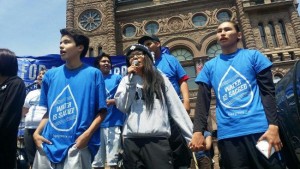Grassy Narrows First Nation seeking justice for their right to a basic need: clean water

By Barb Nahwegahbow
TORONTO—“They are the future and they are the ones we have been fighting for all this time,” said grandmother Judy Da Silva of Grassy Narrows First Nation. Da Silva was speaking to a crowd of more than 1,000 supporters at a June 2nd rally at Queen’s Park calling for justice for Grassy Narrows First Nation.
Da Silva was talking about the youth who had travelled 1,700 km by bus from Grassy Narrows to Toronto, a trip that took 2 days. The youth had just performed a song they wrote about their community called, Home to Me. “This song that these young people made has made me cry so many times,” said Da Silva. “I wanted to cry again, but I kept my composure so I could talk to you.”
“We are a powerful people,” she said, “and I want people to understand that we are not weak. We are strong and we’re not going to give up. It’s a big monster we’re fighting and that fight is to protect our water and the future generations of children.”
Da Silva told the supporters, “With you standing behind us and pressuring the government, you amplify our voice.”
Faisal Moola, a scientist with the David Suzuki Foundation and professor at York University and University of Toronto, reminded the supporters of the history of Grassy Narrows. “In 1962,” said Moola, “the Ontario government gave permission to a pulp and paper company in Dryden to dump 10,000 kilograms of toxic mercury waste into the Wabigoon River. The people of Grassy Narrows have been dealing with the results of that ever since.”
Moola talked about the report authored by three renowned scientists that was just released. They have said the Wabigoon River can be cleaned of the mercury. “The water can be cleaned, the fish can be safe again, but it’s only going to happen if there is political will,” said Moola.
On behalf of the David Suzuki Foundation and their tens of thousands of supporters across the country, Moola urged Premier Wynne to listen to the science and finally bring justice to the people of Grassy Narrows.
“It’s time to bring an end to government-sanctioned abuses of First Nations people,” said Dawn Bellerose, the Aboriginal representative on the Executive Board of CUPE.
“I came here today to say that 250,000 CUPE members in Ontario stand in solidarity with the people from Grassy Narrows.” Bellerose said CUPE is committed to join the fight to get the government to clean the river of mercury and stop all industrial logging in and around Grassy Narrows.
Chief Simon Fobister of Grassy Narrows said the support for their struggle was, “awesome,” especially all the organizations, he said.
Fobister is hopeful the new report, funded by the Ontario Government, will lead to positive action from Premier Wynne. “Our main goal is to get the river cleaned up,” he said. “All these decades they failed to do so. I hope this time they won’t drop the ball. I hope this time, they’ll do the right thing.”
The group marched from Queen’s Park along University Avenue and onto College Street, stopping at a couple of major intersections for a round dance. The march ended at Allan Gardens at Jarvis and Carlton streets.
Tori Cress of Idle No More marched with Grandmother Judy Da Silva. “This is a great opportunity for the rest of Ontario to get engaged with Indigenous communities, bringing the oppressive roblems like environmental racism right to the Legislature,” Cress said. “It’s important to make people aware that northern Ontario is a dumping ground for chemicals. And it’s gonna keep happening like with the Ring of Fire and we need to make people aware of the environmental damages we’re gonna be facing in the future.” Cress is a citizen of Beausoleil First Nation.


